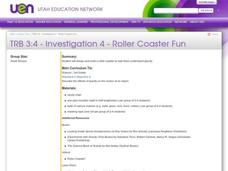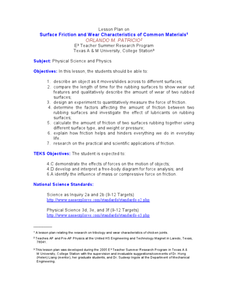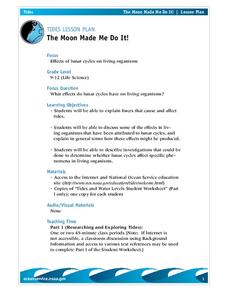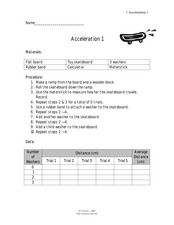Curated OER
Motion in a Circle
Students explore uniform circular motion, and the relation of its frequency of N revolutions/sec with the peripheral velocity v and with the rotation period T. They examine how uniform circular motion is a type of accelerated motion.
Curated OER
Accelerated Frames of Reference: Inertial Forces
Students examine how when applying the laws of motion to an object in an accelerating frame, using coordinates defined in such frame, one must always add an "inertial force", representing forces caused by the frame's acceleration.
Curated OER
Newton's Laws
Students give examples of each of Newton's three laws as they occur in everyday experiences. They visually represent and differentiate the difference between a direct proportion and an inverse proportion. Students explain how the...
Curated OER
How Do Probes Get To Space
Students investigate how force works to propel rockets into outer space. In this physics lesson, students use a drinking straw, fishing line, a balloon, and tape to explore how force works in outer space. Students repeat the experiment...
Curated OER
"Shapes" Dance Lesson Plan
Sixth graders create dances by manipulating shapes with their bodies.
Curated OER
"Orientation to Dance" Dance Lesson Plan
Students learn their rights and responsibilities within the context of the dance class.
Curated OER
Introduction to Friction
Students study the properties of the frictional force between two surfaces in contact. They inspect various phenomena in nature where friction plays an important role and demonstrate
Curated OER
Roller Coaster Fun
Third graders review the effects of gravity on how objects move. In groups, they design a roller coaster and share it with their classmates. Using materials given to them, they build their roller coaster and let a ball roll on the...
Curated OER
Simple Machines V - Wheels and Axles and Gears
Fourth graders investigate the principles and uses of gears, and examine how gears can be used to alter the direction of motion or the speed of an object. They observe two cars with different sized wheels roll down an inclined plane,...
Curated OER
What a Drag
Students learn examples of friction and drag, and suggest ways to reduce the impact of these forces. The equation that governs common frictional forces is introduced, and during a hands-on activity, students experimentally measure a...
Curated OER
Surface Friction and Wear Characteristics of Common Materials
High schoolers identify the factors affecting friction. In this physics lesson, students construct their own rocket car and race them. They graph the average speeds and discuss how lubricants affect friction between rubbing surfaces.
Curated OER
Simple Machines
Fourth graders discover the principles and uses of gears noting that they can be used to change the direction of motion or the speed of an object. They may also change the force and/or distance through which an object turns. They then...
Curated OER
The Moon Made Me Do It!
Students research about how lunar cycles affect living organisms. In this biology lesson, students prepare an oral presentation of their research results and analyses. They explore the forces that affect tides.
Curated OER
Rocket Angles
Eighth graders create rockets that be launched at varying angles to determine which angle is best to launch at for the longest distance.
Curated OER
Clouds
Students explore clouds. In this weather lesson, students identify the steps in the water cycle, define condensation and evaporation, and relate this information to cloud formation. Students perform a cloud experiment,...
Curated OER
Egg Walk Challenge
Students design plastic shoes to walk on eggs without breaking them. In this pressure lesson, students consider all the factors needed to design shoes to walk on eggs without breaking them. Students calculate the PSI pressure, the force...
Curated OER
The Phenomenon of Sound: Waves
Students explore sound waves. In this sound waves lesson, students brainstorm different sounds and how sounds move or travel. Students then create a KWL chart and work through six different lab activities to examine how sound waves...
Curated OER
Go Car, Go!
Learners design and build their own car. In this physics instructional activity, students collect data to determine the speed of the car. They plot the data on the graph analyze the relationship between variables.
Curated OER
Rocket Science
Students conduct an experiment. In this physical science lesson, students learn about Isaac Newton's theory that for every action there is an equal but opposite reaction. Students show this theory by looking at how a rocket is propelled...
Curated OER
Properties of Matter (Biomaterial Through Nanotechnology)
Learners investigate friction between different surfaces. In this physics lesson, students research biomaterials that can reduce friction. They calculate efficiency using a mathematical formula.
Curated OER
Acceleration 1
In this acceleration worksheet, students use weights to increase the mass affecting the force on moving objects. Students plot a graph of their data and answer 3 questions about how the acceleration of the toy skateboard used in the...
Curated OER
Free Up the Ketchup!
Students, in teams, use given materials and their knowledge of Newton's First Law to create a device that will remove a sticky ping pong ball from a 16-oz. cup (which represents ketchup stuck in a bottle.)
University of Colorado
Happy Landings: A Splash or a Splat?
Huygens spacecraft landed on Saturn's moon Titan in 2005, making it the farthest landing from Earth ever made by a spacecraft. In this hands-on activity, the 12th installment of 22, groups explore how density affects speed. To do this,...
University of Colorado
Distance = Rate x Time
Every year, the moon moves 3.8 cm farther from Earth. In the 11th part of 22, classes use the distance formula. They determine the distance to the moon based upon given data and then graph Galileo spacecraft data to determine its movement.























